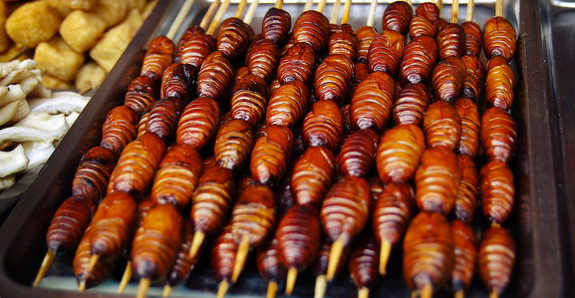The Best Way to Handle the Coming Cicada Invasion? Heat Up the Deep Fryer
For 17 years, these insects have been lurking, waiting to return, so here are some suggestions to eat your way through the infestation
![]()

Cicada pupa are fried and served on a stick in China. Creative Commons photo by Lara Warman.
No one knows exactly when they’ll come out of hiding, but if you live on the East Coast – anywhere form North Carolina to Connecticut, to be precise – you might start thinking about the brood of cicadas scheduled to make an appearance this spring.
Yes they’ll be loud and inconvenient, but they’ll also be a free, plentiful source of protein (and one that’s not generated in a factory farm).
Here’s what you should know about foraging and eating this extremely rare food.
1) First off, don’t pick up or eat dead cicadas. Gathering live ones shouldn’t be very hard, especially if you pick them up “early in the morning when the dew is still on the ground and the cicadas are still drowsy,” says one expert. The easiest way to kill them is by placing them in the freezer.
2) Gather twice as many as you and your family think you can eat. Van Smith, who wrote about his experiments eating cicadas for Baltimore City Paper, explains why: “Females are preferable for their protein-filled abdomens, while males offer little substance. When hunting them, though, I found it nearly impossible to tell the difference–until cooking, when the males’ bodies shrivel up. Marinating live bugs in Worcestershire sauce also helps weed out guys (the vinegar in the sauce slow-cooks them, so they start to collapse) while tenderizing the ladies.”
3) Think of them like “land shellfish.” Like shrimp, lobster and crabs, cicadas are anthropods arthropods. Gaye L. Williams, an entomologist from the Maryland Department of Agriculture told the Baltimore Sun: “They’re in the same animal group as shrimp and crabs, and people don’t think twice about that.” (If you’re allergic to shellfish, exercise caution when experimenting with cicadas).
4) Like many things, cicadas taste best fried. Here’s a simple recipe that only requires living cicadas, flour, eggs, salt, pepper, and oil. If they’re newly hatched, you can fry them as-is, but after they’ve been alive for several hours (or few days), their wings and legs might need to be removed, as this recipe for deep dried cicadas calls for. In Asia it’s not unusual to find the pupa, or young cicadas fried and served on a stick like this.
Kirk Moore, who calls himself the “Cicada Chef” also recommends marinating them overnight in Worcestershire sauce in this YouTube video from 2004.
5) Dry roasting them – on a cookie sheet at a low heat — is another popular approach. If they get too crispy to eat as-is, they can be crumbled to add crunch to a dish or even ground into a high-protein (gluten free!) flour.
6) Young cicadas can also be used in a “low country boil” or a “spice boil” in place of shrimp.
7) Have leftovers, go fishing! Cicadas are rumored to make excellent fish bait.
Bonus video:
Editor’s Note, April 15, 2013: Entomologist John Cooley of the University of Connecticut chimes in with a note of caution: “We actually try to discourage eating cicadas. There’s a body of literature showing that periodical cicadas are mercury bioaccumulators and some can have relatively high mercury levels.”